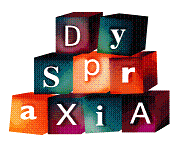Dyspraxia
Dyspraxia

What Is Dyspraxia?
- Dyspraxia is a neurologically based developmental disability which is present from birth
- Dyspraxia is a motor planning disorder, not a muscular deficit. A child knows what they want their body to do but can’t get their body to do it.
- There are three (3) types of Developmental Dyspraxia – Oral, Verbal and Motor.
- A child with Dyspraxia can have one or a combination of all three types of Dyspraxia and in varying degrees of severity
- Dyspraxia is a hidden handicap. Children with this disability appear the same as any other child. It is only when a skill is performed that the disability is noticeable.
- Dyspraxia is believed to be an immaturity of parts of the motor cortex (area of the brain) that prevents messages from being properly transmitted to the body.
- Dyspraxia affects up to 10% of the population with approximately 70% of those affected being boys.
- Dyspraxia does not impact on intelligence, children with Dyspraxia have average or above average intelligence
- Dyspraxia can impact on behaviour and social skills
- Dyspraxia is a specific learning disability
What is Oral Dyspraxia?
Oral dyspraxia is a difficulty with planning and executing non-speech sounds, such as blowing, sucking or individual tongue/lip movements. This may indirectly affect speech and/or swallowing skills. A child with Oral Dyspraxia may dribble profusely, have difficulty licking an ice-cream and may have a preference for either soft or hard textured foods.
What is Verbal Dyspraxia?
Verbal Dyspraxia is a speech disorder that affects the programming, sequencing and initiating of movements required to make speech sounds.
Children with Verbal Dyspraxia may:
- Display highly unintelligible speech
- Simplify words eg. “bur“ for “burger
- Have inconsistent speech patterns
- Move sounds in a word eg. “tobe“ for “boat“
- Exhibit “lost“ or searching movements of the tongue and lips as they endeavour to find the position to make a sound
- Have delayed expressive language
- Adopt a complex gesture system to aid communication skills
- Have difficulty with sequencing words, and sounds in words eg. “Pataka“

What is Motor Dyspraxia?
Motor Dyspraxia is a difficulty in planning, sequencing and then executing the correct movement to perform age appropriate skills in a smooth and coordinated manner at will or on command.

Children with Motor Dyspraxia may have difficulty with:
- Learning a new skill
- Coordinated movement
- Handwriting
- Consistent performance
- Age appropriate skills
- Generalising learnt skills
- Timing and rhythm
- Learning rules
- Responding quickly
- Spatial organisation
- Problem solving
- Using appropriate cues
- Analysing what is needed for task performance
- Preparing for the next stage in task performance
Depending on the dyslexia diagnostic assessment and the severity of the disability one or more of the following programs may be recommended:
About Us
Our aim is to provide quality educational assistance to students in a rural situation in the South East of South Australia
Contact Us
0473883139
carol@kl3.com.au
PO Box 1176
5 Pinkerton Rd
NARACOORTE SA 5271
